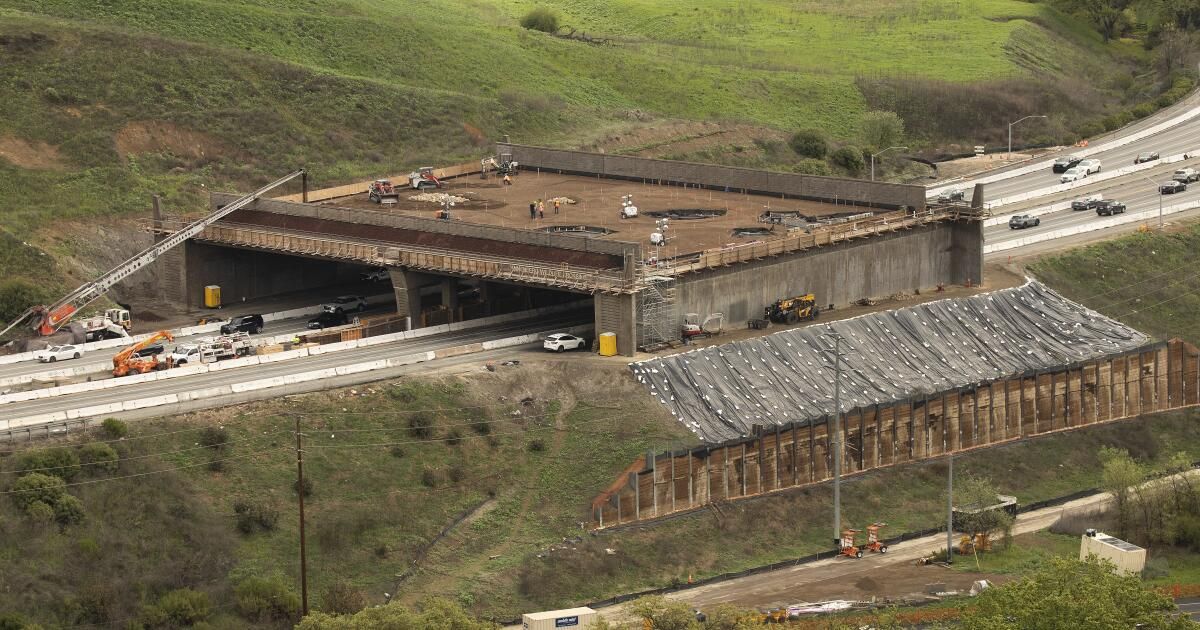On Monday it was transcendental for the crossing of the wildlife of Wallis Annenberg, although it still looked like a bridge for no part of the 101 highway, where more than 300,000 vehicles run incessantly every day.
Almost three years after the project began, the critical milestone was visible only for government officials, scientists and followers who rose to the top: the ground.
And not only any floor. In the next few days, 6,000 cubic yards of soil will be added specially manufactured to cover the crossing, a mixture of sand, silt and clay inoculated with a little compost and hyperlocal mycorrhic fungi, designed and carefully tested to imitate the biological composition of the native soils around the site.
The plan is to add 6,000 cubic yards of land, contoured to different depths, to the upper part of the crossing of Wallis Annenberg's wildlife.
(Al SEIB / for times)
Adding Earth is a big problem because it means that we are approaching at the end of stage 1, when the upper part is sown and then plant with bushings and native perennial plants, the work that must be completed this summer, said Robert Rock, executive director of Rock Design Associates based in Chicago and the landscape architect that supervises the project.
But we are still very far from the completion, now scheduled by the end of 2026, approximately one year after the initially planned due to the delays of heavy rains in 2022 and 2023.
Stage 2, the final phase, will connect the structure with the hills in the north and the south so that wildlife, such as the famous and failed Cougar, P-22 of the, can use it. That stage will begin to bury public services lines along a ROAD, south of the crossing section, and the moving water lines for recycled water used for irrigation.
At the end of 2025 or beginning of 2026, Agura Road will be closed for a few months so that the road can be covered with a tunnel and a lot of land collected from the Malibu Lake area. The objective is to create natural slopes outside the crossing: an additional 12 acres that will be planted with native bushes, perennial plants, herbs and trees so that the crossing is mixed as much as possible with the surrounding hills.

Beth Pratt, left, Regional Executive Director of California of the National Federation of Wildlife, Penny Sylvester, Middle, Mayor of Agouh Hills and Jeremy Wolf, right, mayor of Agura Hills Pro Tem, laugh while throwing the first ground at the top of the Wallis Annenberg Wail Life Cross in the exhaustion hills.
(Al SEIB / for times)
“Basically, they are restoring the mountain to what was once, so wildlife will not even know that they are crossing the highway,” said Jeremy Wolf, the mayor, Pro Tem de Aractura Hills, who was among several government officials, scientists and life defenders who came to celebrate the arrival of the ground on Monday.
“Humans created this problem,” Wolf said in an interview. “We have created habitat islands fragmentation with our roads and homes that increasingly invade in the wild urban interface, and now we are solving this problem using human ingenuity for good purposes.”

Beth Pratt, Regional Executive Director of California of the National Wildlife Federation, on the right, shows his P-22 Suéter Cougar to celebrate with Robert Rock, the landscape architect who supervises the construction of the Wallis Annenberg wildlife crossing, when the ground finally begins to flow at the crossroads.
(Al SEIB / for times)
There has been a lot of ingenuity and innovation on the road and much attention to detail. For example, even before construction began in 2022, the project built a nursery and sent horticulturists combing the hills around the site to collect approximately 1 million seeds of around 30 species of native plants. These seeds were planted and have been nourished in 1 gallon pots.
Mycologists (biologists studying fungi) collected beneficial mycorrhic fungi and other microbes of the area to inoculate the soil used to cultivate plants and cover the upper part of the structure.
Information sheet
The Times register for our plant newsletter
At the beginning of each month, obtain a summary of the next activities and events related to the plant in southern California, along with links to tips and articles that may have lost.
Occasionally you can receive promotional content from Los Angeles Times.
They also tested what the native seeds interact better with that fungus, and chose four to sow as a coverage crop before adding the plants to help “advance” in the growth of beneficial fungi in the soil, which helps plants access nutrients and water they need to prosper. These seeds will be sown at the end of this month, said Rock: Golden Yarrow (Eriophyllum Conbertiflorum)California Poppy (Cashscholzia Californica), Giant wildrye (Elymus condensatus) AND SANTA BARBARA MILK VETCH (Astragalus tricopodus)which admits more than 20 butterflies, including the blue green sticks in danger of extinction.

The members of the media, scientists, government officials and lifelong followers walked through a muddy slope from Agura Road to highway 101 to be able to walk to the top of the crossing of Wallis Annenberg's wildlife.
(Al SEIB / for times)
It took almost a year of preparation to prepare the upper part for the construction of thick 12 -foot high walls to minimize the noise and visibility of the traffic and add a special drain Native do not like wet feet.
Meanwhile, the ground mixed and “matured” in a place in López Canyon north of Pacoima, where it has been analyzed and adjusted to ensure that pH levels and chemical compounds are balanced. Rock said that its final mix had slightly high chlorine levels, so they had to water it deeply to help dilute and eliminate that excess chemical compound.

Fran Pavley, a former member and senator of the State Assembly, was the first mayor of Agura Hills when the city joined in 1982, and fought to keep the land without developing on both sides of the Wallis Annenberg wildlife crossing, more than 40 years before the project began.
(Al SEIB / for times)
On Monday, a small army of followers and media rose to the top of the structure to witness the propagation of the soil. The visitors included the former state senator and the Fran Pavley Assembly, the first mayor of Agura Hills after the city joined in 1982, who fought to keep the wild areas open on both sides of the 101 highway for some type of wildlife crossing; Wildlife biologists Miguel Mardañana (who discovered P-22), Jeff Sikich and Seth Riley, who have tracked and investigated for a long time the mountain lions and other wild lives in the mountains of Santa Monica, and Beth Pratt, regional executive director of California for the National Federation of Wildlife, which helped raise $ 92 million in the $ 92 million in the $ 92 million in the $ 92 million State and private races to build the corridor.

A view of cars that lead under the crossing of wildlife.
(Al SEIB / for times)
Shortly before 8 am, a long and narrow conveyor device began to pull the land of the trucks on the north side of the highway up to 60 feet to the upper part, where it extended around the structure with compact road loaders, essentially small ground engines that use clues instead of wheels to minimize the compaction of the soil.
The upper part of the structure is 174 feet wide, wider than a football field. If the ground spread evenly, it would have approximately 18 inches deep, said rock, but the goal is to imitate adjacent hills, so the ground is contouring 1 to 4 feet deep, with a few pockets of small sandstone rocks. In the following month, more or less, some large volcanic rocks will also roller to the top, so that it coincides with the geology of the region, which includes a small streak of volcanic rock.

These holes are where the volcanic rock will be placed later.
(Al SEIB / for times)
After the seeds have the opportunity to cultivate and energize the soil, shrubs and mature perennial plants, they will probably be planted in mid -May, Rock said. These plants, grown from locally collected seeds, include black sage, white sage and purple sage, Sarracene wheat of California, Sarracene wheat of long stem and sarracene wheat of Cinderella leaf, wild grape; close leaves algodoncillo, California shrub sunflower; Venado poison; Supply, Toyon, Laurel Sumac and Ceanothus.
They will also maintain an open sharp eye for invasive that could move newly planted native plants, aggressive plants such as black mustard, which is already exuberously sprouting along the southern edge of the corridor. The black mustard grows rapidly and will soon send seeds that could easily invade the pristine soil in the structure.
But in this matter, the builders of the world's largest wildlife corridor are on the same ship as the gardeners everywhere. “We will only have to eliminate it until [native] The plants are established, “he said.” The sad reality is that there is very little more than we can do. “











